Wet weeks split state’s planting season in two
Published 12:14 pm Thursday, May 20, 2021
By Bonnie Coblentz
MSU Extension Service
Because it is the first crop planted starting in March, Mississippi corn is in much better shape than other row crops struggling with the challenges of wet, cool weather.
The U.S. Department of Agriculture released estimates May 16 that indicate 97% of the state’s corn is in the ground, and 83% appears to be in good or excellent condition. Of Mississippi’s other primary row crops, rice is 89% planted, soybean is 72% planted, and cotton is 49% planted.
Erick Larson, grain crops agronomist with the Mississippi State University Extension Service, said the corn crop is off to a better than normal start with few complications.
“Any time we have dry conditions early in the spring, that’s helpful not only for opportunities to plant the crop, but it is good for the general health of the crop,” Larson said. “Growers are able to conduct other needed operations such as nitrogen fertilizer and herbicide applications in a timely manner.”
Mississippi is expected to have about 640,000 acres of corn in 2021. Larson said producers have had more opportunity to meet or exceed planting intentions this year than in a long time, resulting in more acres.
“Recent cool temperatures and frequent rains have not necessarily helped the crop, but neither have they hurt it,” Larson said.
Cotton, soybeans and rice are not so fortunate.
Brian Pieralisi, Extension cotton specialist, said cotton farmers worry they will miss their planting window because of rains spaced just far enough apart to keep the group too wet to plant for weeks.
“We had some cotton planted before it got too wet and when it was still warm enough to emerge, but now it is just sitting there and not growing,” Pieralisi said. “Those farmers are concerned with replanting, but it hasn’t been dry enough yet to make that decision.”
Many acres of cotton have been planted, but cool nights and inadequate heat in the day have prevented the crop from emerging. Other farmers are still waiting for their first chance to get cotton seed in the ground this year.
“The optimum cotton planting window closed May 10, but farmers often plant well after that date. Ultimately, they would like to be planted by May 25,” Pieralisi said. “If you talk to enough farmers, you will always hear about cotton planted in June that did really well. However, the concern is having enough heat units later in the season to finish the crop.”
Cotton acreage has been declining in Mississippi in recent years. Cotton was down 25% in 2020, and early estimates were that it would drop another 5% this year, bringing the estimated total amount to 500,000 acres. If weather does not cooperate soon, even that number will be cut.
Rice acreage is also down in the state in 2021; USDA projected 120,000 acres, compared with 165,000 acres harvested in 2020. Jason Bond, an Extension weed specialist and Mississippi Agricultural and Forestry Experiment Station researcher, said strong prices for soybeans are partly the reason.
“Rice prices have decreased even more with recent poor weather, and that weather has stalled rice planting,” Bond said. “We really have two rice crops now: an older one and one yet to be planted.”
Growth on the older crop has mostly stalled, and now farmers are struggling to decide whether to make needed herbicide applications on existing rice fields or plant acres that weather has paused. USDA estimates 95% of the rice that has emerged is in good or excellent condition.
Trent Irby, Extension soybean specialist, said soybeans have a brighter outlook. Soybeans are the state’s biggest row crop, with 2.2 million acres expected to be planted in 2021.
“Market prices brought some excitement that we haven’t had for a few years,” he said.
Soybeans are a valuable crop for Mississippi for many reasons beyond market price. They can grow on a wide range of soil types and have a wide planting window. Soybean planting typically begins in early April and can run through late June and beyond.
Early-planted soybeans tend to have the highest yields historically. Irby said producers in some areas got a lot more of the crop planted in April than has happened in the last several years. Even though much of the crop is planted, conditions in May have made it difficult for planting to stay on track.
“If we can just get a few days of sunshine and warmer temperatures, I feel like farmers can cover a lot of ground and get soybean planting accomplished pretty quick,” Irby said.
With cotton, rice and soybeans all having an early-planted and a late-planted crop, management will be a challenge all season. For example, Irby said some soybean acreage will have reached the point where it needs a postemergence herbicide application, while other fields being planted at the same time need a preemergence application.
Find current crop information from the MSU Extension Service online at https://www.mississippi-crops.






